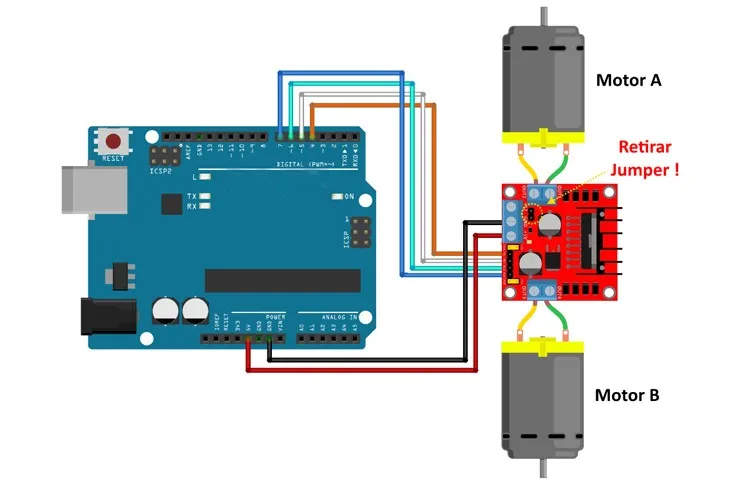L298n Stepper Motor Driver Controller Board For Arduino Manual
Control DC and Stepper Motors With L298N Dual Motor Controller Modules and Arduino: You don’t have to spend a lot of money to control motors with an Arduino or compatible board. After some hunting around we found a neat motor control module based on the L298N H-bridge IC that can allows you to control the speed and dir. Information about the L298N Motor Driver. The L298N Motor Driver Board is built around the L298 dual full-bridge driver, made by STMicroelectronics. With this motor driver you can control DC motors, stepper motors, relays and solenoids. It comes with two separate channels, called A and B, that you can use to drive 2 DC motors, or 1 stepper motor when combined. The L298N Dual H-Bridge Motor Controller is a very versatile device that is sure to find a lot of use in your robotics and IoT projects. Anywhere you want to make things move with an Arduino.
Usage:
H-Bridge's are typically used in controlling motors speed and direction, but can be used for other projects such as driving the brightness of certain lighting projects such as high powered LED arrays.
How it works:
An H-Bridge is a circuit that can drive a current in either polarity and be controlled by *Pulse Width Modulation (PWM).
* Pulse Width Modulation is a means in controlling the duration of an electronic pulse. In motors try to imagine the brush as a water wheel and electrons as a the flowing droplets of water. The voltage would be the water flowing over the wheel at a constant rate, the more water flowing the higher the voltage. Motors are rated at certain voltages and can be damaged if the voltage is applied to heavily or if it is dropped quickly to slow the motor down. Thus PWM. Take the water wheel analogy and think of the water hitting it in pulses but at a constant flow. The longer the pulses the faster the wheel will turn, the shorter the pulses, the slower the water wheel will turn. Motors will last much longer and be more reliable if controlled through PWM.
Pins:
- Out 1: Motor A lead out
- Out 2: Motor A lead out
- Out 3: Motor B lead out
- Out 4: Mo (Can actually be from 5v-35v, just marked as 12v)
- GND: Ground
- 5v: 5v input (unnecessary if your power source is 7v-35v, if the power source is 7v-35v then it can act as a 5v out)
- EnA: Enables PWM signal for Motor A (Please see the 'Arduino Sketch Considerations' section)
- In1: Enable Motor A
- In2: Enable Motor A
- In3: Enable Motor B
- In4: Enable Motor B
- EnB: Enables PWM signal for Motor B (Please see the 'Arduino Sketch Considerations' section)
Specifications:
- Double H bridge Drive Chip: L298N
- Logical voltage: 5V Drive voltage: 5V-35V
- Logical current: 0-36mA Drive current: 2A (MAX single bridge)
- Max power: 25W
- Dimensions: 43 x 43 x 26mm
- Weight: 26g
*Built-in 5v power supply, when the driving voltage is 7v-35v


Usage:
H-Bridge's are typically used in controlling motors speed and direction, but can be used for other projects such as driving the brightness of certain lighting projects such as high powered LED arrays.
How it works:
An H-Bridge is a circuit that can drive a current in either polarity and be controlled by *Pulse Width Modulation (PWM).
* Pulse Width Modulation is a means in controlling the duration of an electronic pulse. In motors try to imagine the brush as a water wheel and electrons as a the flowing droplets of water. The voltage would be the water flowing over the wheel at a constant rate, the more water flowing the higher the voltage. Motors are rated at certain voltages and can be damaged if the voltage is applied to heavily or if it is dropped quickly to slow the motor down. Thus PWM. Take the water wheel analogy and think of the water hitting it in pulses but at a constant flow. The longer the pulses the faster the wheel will turn, the shorter the pulses, the slower the water wheel will turn. Motors will last much longer and be more reliable if controlled through PWM.
Pins:
L298n Stepper Motor Driver Controller Board For Arduino Manual Software
- Out 1: Motor A lead out
- Out 2: Motor A lead out
- Out 3: Motor B lead out
- Out 4: Mo (Can actually be from 5v-35v, just marked as 12v)
- GND: Ground
- 5v: 5v input (unnecessary if your power source is 7v-35v, if the power source is 7v-35v then it can act as a 5v out)
- EnA: Enables PWM signal for Motor A (Please see the 'Arduino Sketch Considerations' section)
- In1: Enable Motor A
- In2: Enable Motor A
- In3: Enable Motor B
- In4: Enable Motor B
- EnB: Enables PWM signal for Motor B (Please see the 'Arduino Sketch Considerations' section)
Specifications:
- Double H bridge Drive Chip: L298N
- Logical voltage: 5V Drive voltage: 5V-35V
- Logical current: 0-36mA Drive current: 2A (MAX single bridge)
- Max power: 25W
- Dimensions: 43 x 43 x 26mm
- Weight: 26g
*Built-in 5v power supply, when the driving voltage is 7v-35v



